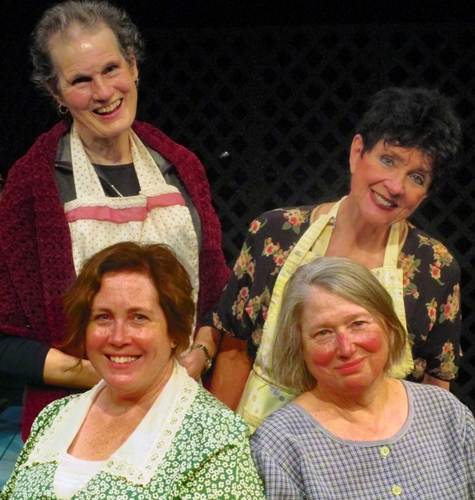Actors Theatre Playhouse opens its 2022 season with Morning's at Seven, Paul Osborn's comedy classic set in a small Midwestern town in the 1920s. This American play tells the story of the four Gibbs sisters, all of whom live within a stone's throw of one another.
Now in their late 60s, the sisters and their husbands find themselves at a dramatic fork in the road.
A website promoting the play for its recent New York revival describes the play as “at once hilarious and deeply touching” and says that “Morning's at Seven lays bare the inner workings of the American family in all its messy, embarrassing, and ridiculous grandeur.”
Stewart McDermet, Wendy Almeida, Heidi Schwieger, Marilyn Tullgren, Ray Mahoney, Sherman Morrison, Charlotte Traas, Mary Armstrong, and Jim Bombicino are featured in the production.
“I had often heard of the play defined as a community theater 'chestnut' over the years, and thought it was just another one of 'those' plays,” director Sam Pilo said in a news release. “Lots for the audience, but not much for the actors.”
“Much to my surprise, its soul sprang right off the page,” he said. “It was cast in my head in a matter of minutes.”
“Its rich blend of human comedy and human self-inflicted tragedy wrapped in the blanket of American family life was just the sort of piece the Playhouse was looking for,” Pilo continued. “And there are so many tiny moments of self-awareness and wry humor as each character trips over the foibles of everyday living that it's a treasure chest for actors to explore.”
In 1939, Morning's at Seven opened on Broadway with great expectations but closed after only 44 performances.
The play found success and acclaim when it was revived on Broadway in 1980, winning a variety of Tony and Drama Desk awards, including Best Revival.
In 2002, the play started a long off-Broadway run, garnering another variety of prestigious theater awards.
Osborn's Brattleboro connection
Pilo said that in doing the research for the production, “a friend, Jerry Carbone, found an article in the Brooklyn Daily Eagle from October 1937 which revealed a treasure chest of information about the group called the Brattleboro Theater in the 1930s, a leader of the youth movement sweeping the national theater world during the Depression.”
“The history of the group and their members has been a pet research project of mine, especially the theater's location in Brattleboro, but information has always been difficult to come by or verify,” he said.
Pilo says that the pursuit for more details and the location of the Brattleboro Theater has over the years yielded claims of connections to well-known actors, such as Anthony Perkins and his father, Osgood Perkins.
He describes those clues as “bits and pieces, but not much we can actually confirm.”
During steamy summers in the city, New York actors and directors would escape to Brattleboro to do a summer stock season. According to the Brooklyn Daily Eagle article, in 1937, after three successful summer seasons, the Brattleboro Theater was preparing to bring a fall season of four plays to the St. Felix Street Theater in Brooklyn.
In 1935, according to the article, an advisory board formed the Brattleboro Theater Company with members including Thornton Wilder (author of Our Town ), Claude Rains (world renowned actor and teacher), and Paul Osborn, among others.
“The group rented the old Estey Estate in Brattleboro, and each player contributed $50 to rebuild the old coach house into a theater,” the Eagle reported, and the group “then embarked on three highly successful Summer theater seasons, during which they established themselves as a serious part of the 'youth movement' that is taking place in the American Theater.”
The Estey Estate is now the Elks Lodge on the Town Common.
Pilo asks: Could the old coach house located on the property and seen from the street be the old Brattleboro Theater?
A few miles away in Vernon, the story of the theater continues - and explains its unraveling.
Florence Louchheim Stol, “heiress to a Wall Street fortune, came to Brattleboro in the 1930s when she married Paul Osborn, an American playwright and protégé of poet Robert Frost,” states a placard at the Governor Hunt House, which later became a part of the Vermont Yankee campus and is now undergoing a transformation into a community center.
“Together, the couple founded a summer stock theatre in Brattleboro, but the theatre, as well as the marriage, dissolved when Osborn began an affair with one of its leading ladies,” the historical marker continues.
Stol was the last residential owner of the historic site in Vernon, purchased in 1947, making it a summer gathering place where prominent people in their fields came to stay for soirees.
In 1940, Osborn and his second wife, fiction writer Millicent Green, left the theater for the West Coast, where his talents were rapidly recognized, particularly his ability to adapt material from other sources.
While not as well-known for his screenwriting, Paul Osborn won admiration of friends and collaborators such as poet Robert Frost and film director Elia Kazan for his treatments of the huge classic cinema hits East of Eden, Wild River, South Pacific, and The Yearling, among others.
“But that's not the career he really wanted (aside from the paychecks) or planned for,” continues Pilo. “Playwriting and the theater were his first and longest love.”
